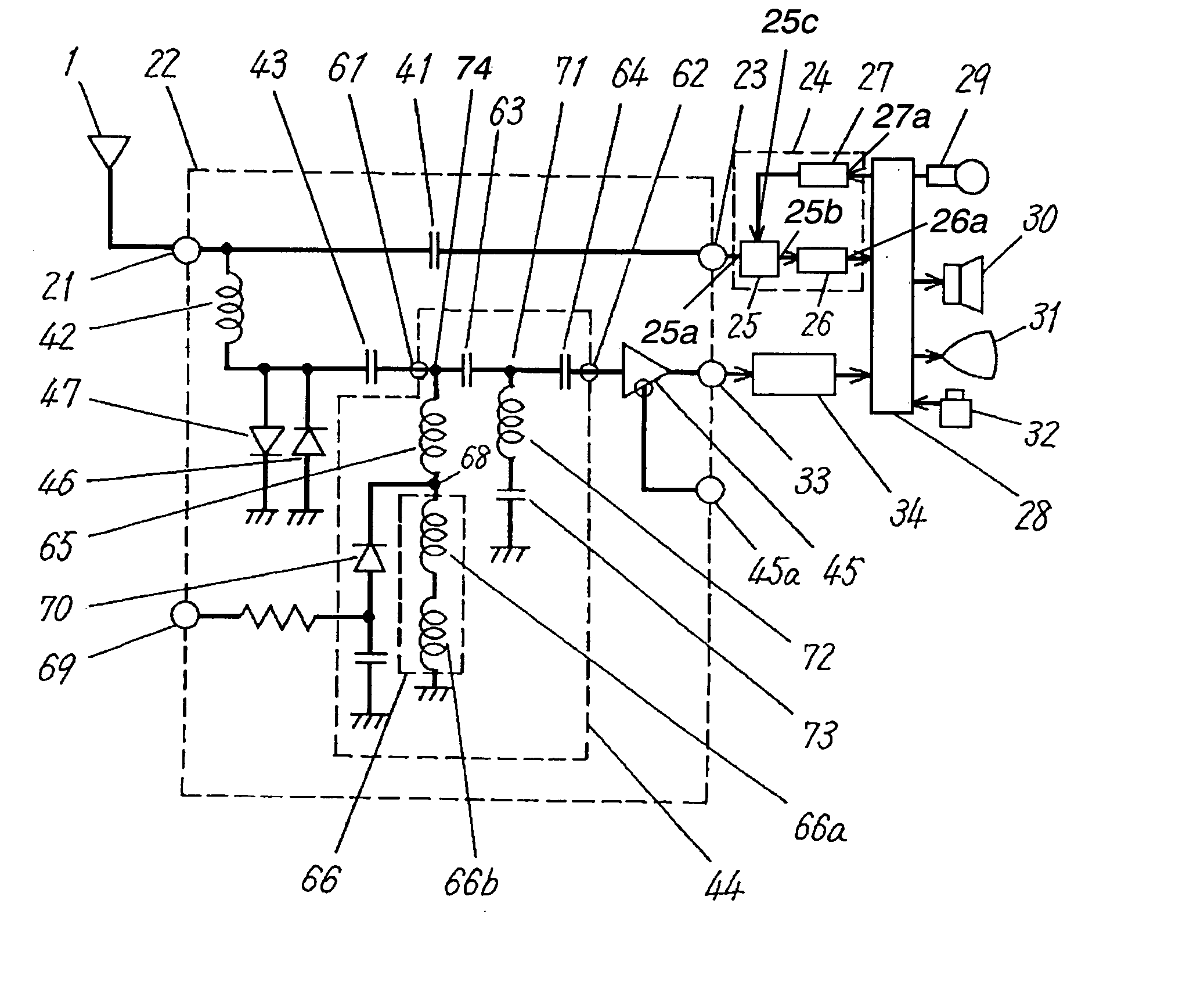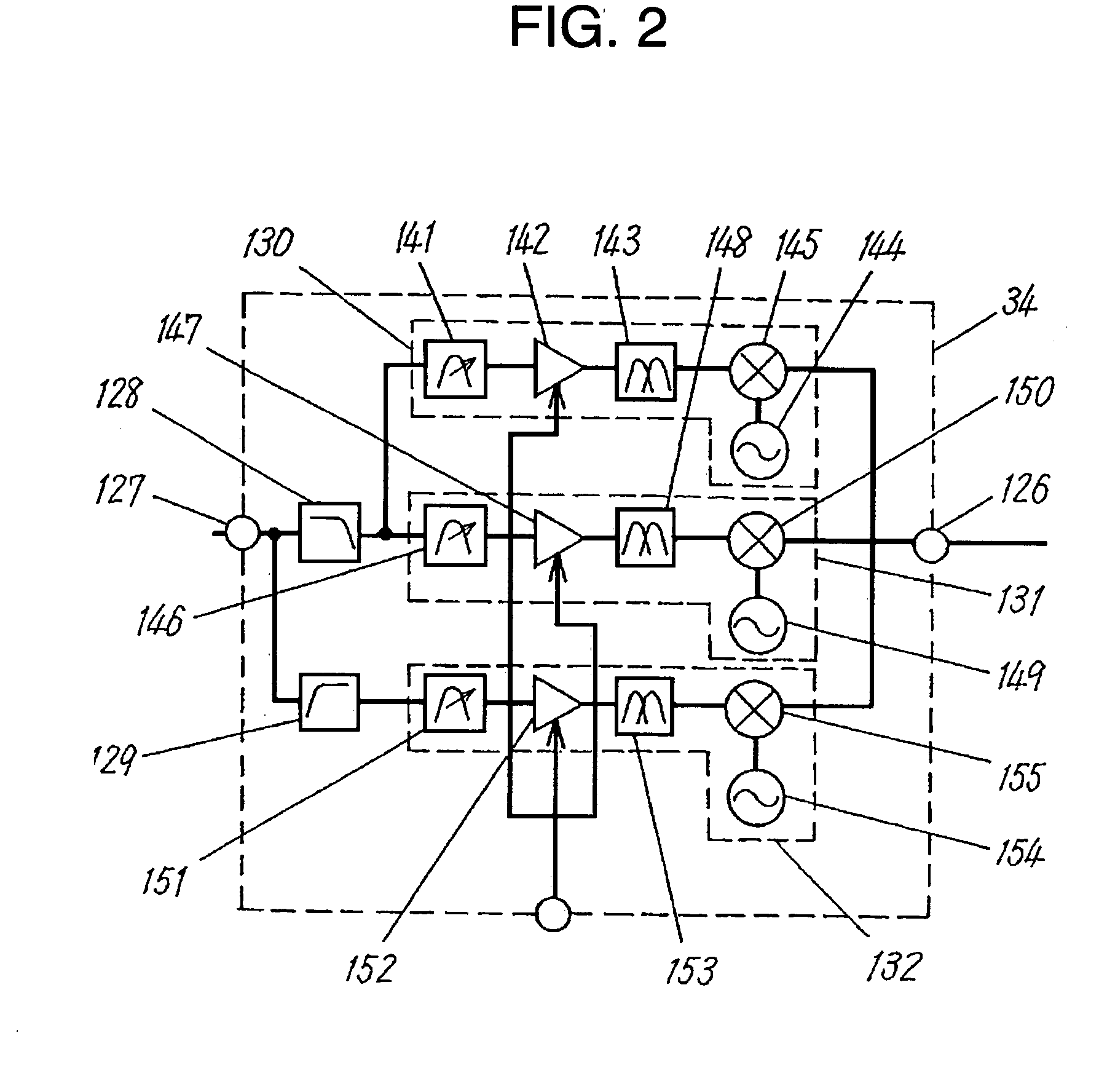Matching unit and receiver apparatus using the same
a technology of matching unit and receiver, applied in the direction of filter, multi-port network, transmission, etc., can solve the problem that the conventional portable device cannot be carried easily, and achieve the effect of small loss
- Summary
- Abstract
- Description
- Claims
- Application Information
AI Technical Summary
Benefits of technology
Problems solved by technology
Method used
Image
Examples
exemplary embodiment 1
[0040]FIG. 1 is a block diagram of a portable receiver according to Exemplary Embodiment 1 of the present invention. Antenna 1 for a mobile phone receives a high frequency signal of about 820 MHz to 900 MHz, a mobile-phone signal. Antenna 1 accordingly has a length of about ¼ wavelengths of the signal, i.e., about 70 mm, so as to have an impedance of 50 Ω at the frequency of the mobile-phone signal. Antenna 1 is also used to receive TV broadcasts in VHF and UHF broadcast bands. Antenna 1 receives TV broadcast signals ranging from a lower limit frequency in the VHF broadcast band (about 50 MHz) to an upper limit frequency in the UHF broadcast band (about 770 MHz), and mobile-phone signals of about 820 MHz to 900 MHz.
[0041] Signals received by antenna 1 is supplied to input / output terminal 21 of splitter 22 also functioning as a matching device. Input / output terminal 23 outputs a mobile-phone signal out of the signals supplied to input / output terminal 21. The mobile-phone signal from...
exemplary embodiment 2
[0095]FIG. 10 is a block diagram of a portable receiver according to Exemplary Embodiment 2 of the present invention. In FIG. 10, the same elements as those shown in FIG. 1 will be denoted by the same reference numerals and their description will be briefed. The receiver according to Embodiment 2 includes a diplexer functioning as a matching device capable of receiving FM broadcast and TV broadcast, and performing communication with a mobile phone. Antenna 1 receives FM broadcast signals ranging from 76 MHz to 108 MHz as well as TV broadcast signals and mobile-phone signals of about 850 MHz.
[0096] As shown in FIG. 10, antenna 1 is connected to high-frequency input / output terminal 311 of splitter 310, and input / output terminal 312 outputs mobile-phone signals. Input / output terminal 312 is connected to transmitting / receiving section 24 and supplies the mobile-phone signals to the section. Transmitting / receiving section 24 is connected to signal processor 28. In splitter 310, output t...
exemplary embodiment 3
[0151]FIG. 20 is a cross sectional view of receiver 1520 according to exemplary Embodiment 3 of the present invention. Receiver 1520 includes splitter 310 shown in FIG. 10 according to Embodiment 2.
[0152] Antenna 521 has at its end mounter 521a fixed at case 560 made of insulating material, such as resin. Tip portion 521b of mounter 521a is connected by either solder 562 or a screw to a conductor on printed circuit board 561 accommodated in case 560.
[0153] Antenna 521 has moving portion 563 between main body 521c and mounter 521a. Moving portion 563 is rotatably in two directions 1521 and 1522 supported by mounter 521a. Splitter 310 is mounted on printed circuit board 561, and antenna 521 is electrically connected to input / output terminal 311 with each other by solder 562.
[0154] In receiver 1520 having the above structure, in order to compensate a decrease of receiver sensitivity due to the directivity of antenna 521, moving portion 563 is moved so as to locate antenna 521 at a p...
PUM
 Login to View More
Login to View More Abstract
Description
Claims
Application Information
 Login to View More
Login to View More - R&D
- Intellectual Property
- Life Sciences
- Materials
- Tech Scout
- Unparalleled Data Quality
- Higher Quality Content
- 60% Fewer Hallucinations
Browse by: Latest US Patents, China's latest patents, Technical Efficacy Thesaurus, Application Domain, Technology Topic, Popular Technical Reports.
© 2025 PatSnap. All rights reserved.Legal|Privacy policy|Modern Slavery Act Transparency Statement|Sitemap|About US| Contact US: help@patsnap.com



